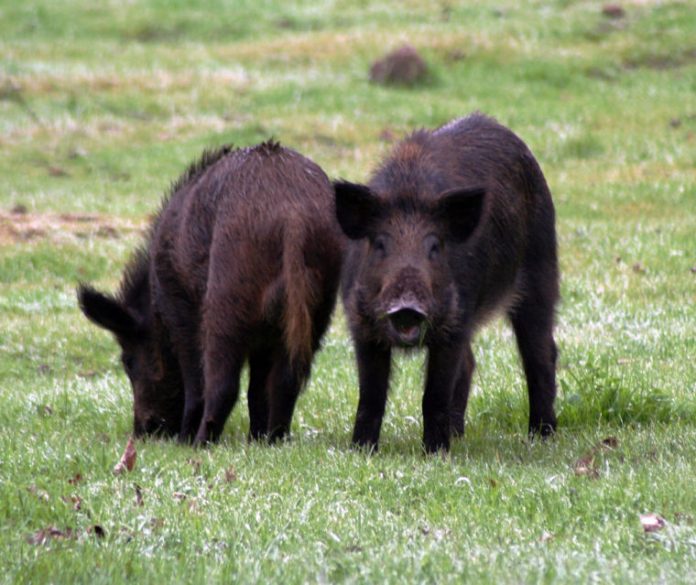Residents of Almaden Valley have recently been suffering from an invasion of wild pigs. These creatures have severely damaged a local golf course and many private yards, leaving lawns looking like a rototiller was set loose upon them. Needless to say, golfers and homeowners are dismayed, angry and frustrated at the extensive damage.
Where did these animals come from, and why do they do this? Pigs were originally brought to what is now Florida by explorer Hernando de Soto in 1539, to be used for food by his men. Other explorers brought pigs to California. Over the years, these prolific animals have gone forth and multiplied throughout much of the United States. California is now classified by the U.S. Fish and Wildlife Service as one of 11 states with a “large, well-established and growing population of wild pigs.”
Residents of Almaden Valley would surely agree that their population of pigs seems to be large and well established, not to mention well-fed. But wild pigs are frequently found in other parts of Santa Clara County, too. They, or the dug-up fields they leave as evidence of their presence, are often seen in parks throughout the South County.
Why do wild pigs cause such damage to lawns and fields? They are simply looking for food. Omnivorous creatures, their diet consists of plants, ground-dwelling insects, worms, reptiles, amphibians, fish, small mammals and carrion, even including other pigs. Under the grass they will find acorns which have fallen from oak trees and settled into the sod, plus grubs, bugs, bulbs and other small animals. They turn over the sod with their snouts and push their noses through the dirt, scooping up a meal and destroying whatever is growing in the process.
Although their behavior has made headlines recently, wild pigs have been an issue for landowners since humans first settled and began building homes in the valley. People have been taking over space that the pigs, although not native, once claimed. In the process, people have provided the pigs with enticing, well-watered lawns under which to find a satisfying meal.
All of this leads to the question, what can be done to protect people’s property? The San Jose City Council recently passed a measure to allow landowners to obtain what are known as depredation permits from the California Department of Fish and Wildlife, to shoot and kill wild pigs on their property.
Callers to WERC have expressed concern for the survival of the pigs, urging WERC volunteers to try to humanely remove the pigs from the areas where they are causing damage.
Sadly, it is not that easy. Wild pigs cannot be simply shooed away, nor are they easily scared off. An adult wild pig can weigh 200 pounds. The boars (males) are equipped with tusks. They have poor eyesight but a terrific sense of smell, and are likely to charge a human who comes too close for their comfort. People should not try to approach them.
As a non-native species, wild pigs have an adverse effect on our local native animal and plants. Their rooting behavior damages native plants and makes it easier for non-native plants to take over, thus threatening the existence of native animals and insects that depend on native plants for survival. They consume great quantities of fruits, nuts and seeds, which not only decreases the ability of new plants to germinate but also reduces the food supply for native animals like deer. Lastly, they carry and can transmit nasty illnesses and parasites, which can infect other animals as well as humans.
The National Park Service, whose mission includes the protection and preservation of native plants and animals, has gone so far as to construct special fences around the entire perimeter of Pinnacles National Park. These fences allow other animals to cross but prevent wild pigs from entering the park. After these fences were built, the pigs existing within the fenced area were eradicated.
Did the City of San Jose make the right decision? This is a difficult issue. These are non-native animals that threaten the survival of native animals and carry transmittable diseases. When they come into contact with human development they cause extensive, unsightly and costly damage. Other than requiring landowners to construct Park Service-like fences, there are few realistic options.
Amy Randall Yee has lived in Santa Clara County for 35 years, and has volunteered at WERC for six years. She is also the President of the Board of Directors of WERC.










